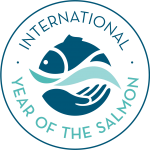Looking Back to Look Forward: Lessons from the 2019 & 2020 GoA Expeditions for the Planning of the 2022 Pan-Pacific Winter High Seas Expedition
Caroline Graham, IYS High Seas Coordinator
Camille Jasinski, IYS Communications Coordinator
June 8, 2021
During their complex life cycle, salmon can spend anywhere from 1 to 6 years in the open ocean. As an anadromous species, they are born in freshwater streams, migrate to the ocean for most of their adult life, and return to their natal streams to spawn. But scientists are reckoning with the fact that much of what salmon experience once they enter the ocean is not well understood. There remain huge gaps in our understanding of the mechanisms that regulate the abundance, distribution, migration, growth, fitness, and survival of Pacific salmon and surrounding species once they migrate from freshwater into the North Pacific Ocean (NPO). Some scientists believe that the ability of juvenile salmon to survive winters in the NPO can be determined during their first few months at sea.
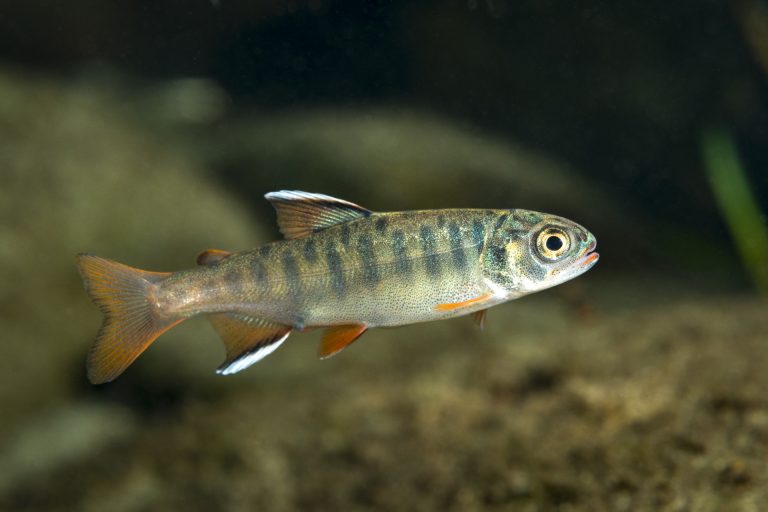
Anomalous events in the NPO, coupled with an increasingly volatile environment and anthropogenic influences on ecosystems make it difficult for scientists to predict changes to salmon abundance, as rapid changes increasingly threaten these iconic species. A concerted international effort is imperative to improve our understanding of what happens to Pacific salmon in the high seas, Dr. Richard Beamish (DFO Emeritus Scientist) and Dr. Brian Riddell (Pacific Salmon Foundation), along with the North Pacific Anadromous Fish Commission (NPAFC) and the International Year of the Salmon (IYS), as well as partners from government, academia, NGOs and private industry have successfully planned and carried out two research expeditions in the Gulf of Alaska in 2019 and 2020 – the first salmon winter ecology surveys conducted in the Gulf of Alaska in decades. These expeditions brought together scientists from Canada, Japan, the Republic of Korea, the Russian Federation, and the United States in an effort to better understand mechanisms affecting salmon in the Gulf of Alaska and effectively share and communicate their results.
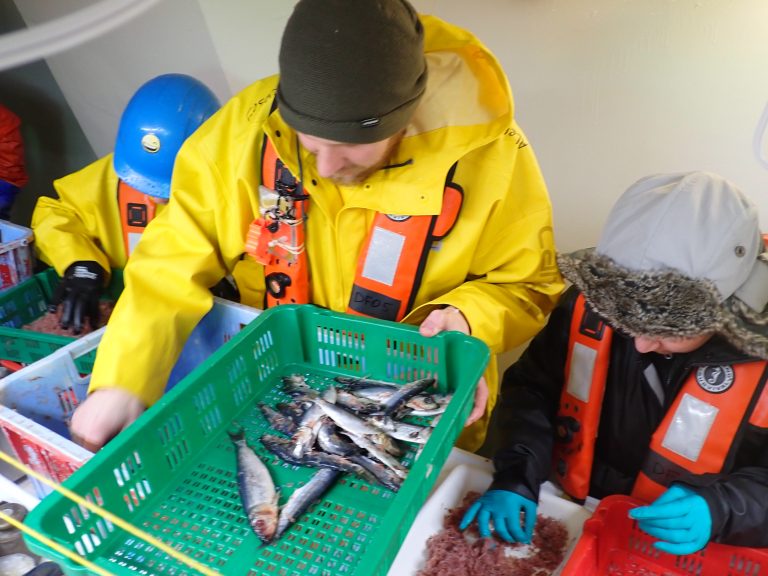
Currently, planning is underway for a pan-Pacific, multi-vessel expedition which will utilize up to 5 vessels to cover 5 zones across the entire NPO, with participants from Canada, Japan, the Republic of Korea, the Russian Federation, and the United States. The IYS 2022 Pan-Pacific Winter High Seas Expedition will build off research from the 2019 & 2020 expeditions, and will be the first ever pan-Pacific epipelagic ecosystem survey to study the biological, chemical and physical oceanography and biota, including salmon and related fishes. The major objective of this expedition is to demonstrate the utility of an international pan-Pacific winter ecosystem survey to better understand the winter ecology of Pacific salmon.
In April 2021, Dr. Beamish, Dr. Riddell and the IYS held the virtual, 3-day Conference on the Winter Ecology of Pacific Salmon: Results from the 2019 and 2020 International Gulf of Alaska Expeditions, which brought international scientists from both Gulf of Alaska expeditions together to share results from the surveys. The successful conference ended with a panel discussion about planning for the IYS 2022 Pan-Pacific Winter High Seas Expedition, which was moderated by IYS Director Mark Saunders. Panel participants consisted of Dick Beamish (2019 & 2020 Gulf of Alaska Expedition Organizer & 2022 Gillnet Vessel Organizer), Jackie King (2022 Expedition Country Lead: Canada), Evgeny Pakhomov (2022 Expedition Chief Scientist), Brian Riddell (2020 Gulf of Alaska Expedition Organizer & 2022 Gillnet Vessel Organizer), Aleksey Somov (2022 Expedition Country Lead: Russia), and Laurie Weitkamp (2022 Expedition Country Lead: USA). Additionally, this panel discussion included a short presentation from Dr. Riddell and Dr. Beamish about the gillnet vessel that will be utilized in 2022 alongside the Canadian trawl vessel to compare the species captured by gillnets compared to trawls.
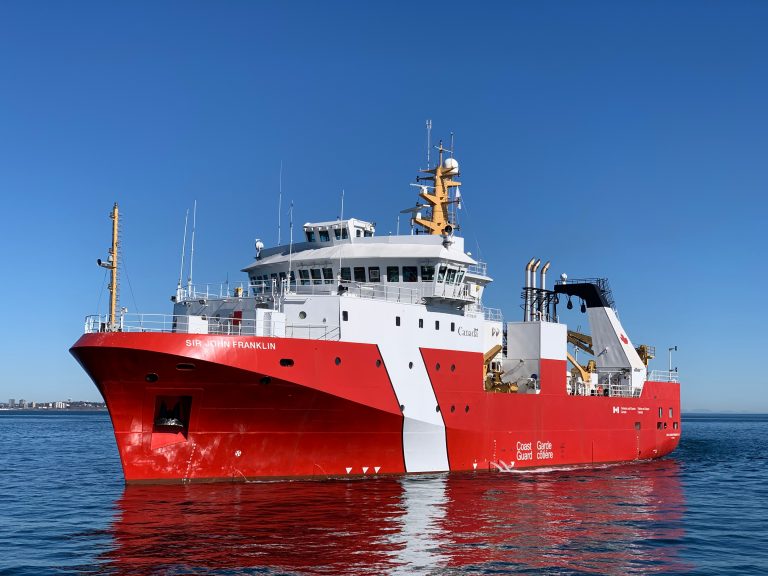
During the panel discussion, participants identified and discussed the major contributions of the 2019 and 2020 Gulf of Alaska Expeditions and how the 2022 Pan-Pacific Expedition could follow up on some of these findings. Panelists emphasized the power of genetic data to provide novel insights, through environmental DNA (eDNA) and salmon genetic stock ID (GSI). Evgeny Pakhomov noted the importance of eDNA to improve our understanding of which organisms are not being captured in the nets, and whether they are salmon prey, predators, or competitors. Laurie Weitkamp commented that it is critical to fill in gaps in salmon genetic baselines to be able to identify which salmon stocks they are encountering in the high seas. Jackie King stated that diet data from 2019 and 2020 were noteworthy, and this raised questions about whether there was competition between salmon species or even other fish and squid. These are just some of the findings that will be important to build on during the 2022 Expedition. Expanding coverage in 2022 to understand salmon distribution in the winter in the North Pacific was also emphasized, since ecological processes are different in the eastern and western NPO. Finally, it was noted that future expeditions should focus on oceanography, hydroacoustic data, and looking into deeper layers of the ocean, and that the gillnetter will be an important addition in 2022 to better understand the catchability of different gear types.
Shigehiko Urawa (2022 Expedition Country Lead: Japan) commented that more research on salmon energy content is required in 2022 since energy content may affect whether salmon survive the winter. He also added that the Japanese summer survey in the Bering Sea can provide important information to complement the winter survey. Brian Riddell underscored the necessity of examining the historical picture to put findings in context and stated that utilizing the plethora of historical Russian ocean data will be key. Aleksey Somov commented that a well-designed high seas survey could reduce uncertainty in forecasted salmon returns. Although large-scale studies are important, we still lack information on the individual behaviour of salmon, such as their vertical distribution and their interaction with changing ocean conditions and eddies. Dr. Brian Hunt (UBC) added that much could be learned by using satellite tags to track the movement of salmon, however, there were challenges in 2019 with tagging salmon at sea.
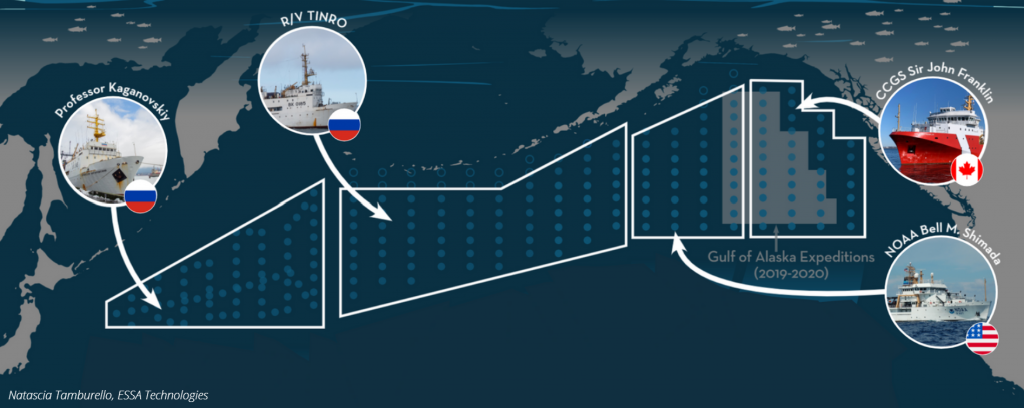
The IYS continues to seek funding for coverage of all 5 zones in the NPO, as the gravity of the need for international collaboration in these North Pacific ecosystem surveys is undeniable. Salmon are critical to Indigenous Peoples, coastal communities and many others around the North Pacific, and there is a lack of knowledge about the ocean phase and what will happen to salmon in a changing climate. Therefore, there must be new ways of thinking and new approaches to research and management to address this gap in understanding and future uncertainties. The 2022 Expedition will be a significant first step towards that future.
